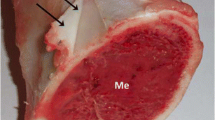Abstract
Objectives
The objective of this study is to evaluate the relationship between the radiological features of periosteal reactions (PR) and histopathological features of the lesions.
Methods
A total of 4605 CBCT images were evaluated and they were classified according to their radiological differential diagnosis. Images with pathologies were listed according to their histopathological examinations as cystic lesions, benign tumours, malignant tumours, fibro-osseous lesions and osteonecrosis, while images without pathologies were listed as traumas and others. All groups were reclassified as with or without the presence of detected PR.
Results
Pathologies and traumas were detected in 1801 of 4605 patients. There were 3 PR in 1140 cystic lesions, 4 PR in 102 benign tumours, 16 PR in 43 malignant tumours, 67 PR in 156 osteonecrosis/osteomyelitis cases and 3 PR in 262 trauma cases. As a result of the chi-square test between groups, there was a significant relationship between histopathologic diagnoses and periosteal reaction patterns (p = 0.000).
Conclusions
Although there is a significant overlap between the patterns of PRs, PRs can be used to narrow the possibilities in the differential diagnosis. However, PRs alone are not sufficient variables for differential diagnosis in the absence of cortical bone destruction, localization, clinical and systemic findings.










Similar content being viewed by others
References
Fukuda K. Periosteal reaction. Nippon Igaku Hoshasen Gakkai Zasshi. 1999;59(7):306–12.
Rana RS, Wu JS, Eisenberg RL. Periosteal reaction. AJR Am J Roentgenol. 2009;193(4):W259–72.
Appel W, Schulz RD, Barth V, Wissmann C. Radiological findings in periosteal reaction due to inflammation (author’s transl). Radiologe. 1979;19(8):317–28.
Wenaden AE, Szyszko TA, Saifuddin A. Imaging of periosteal reactions associated with focal lesions of bone. Clin Radiol. 2005;60(4):439–56.
Volberg FM Jr, Whalen JP, Krook L, Winchester P. Lamellated periosteal reactions: a radiologic and histologic investigation. AJR Am J Roentgenol. 1977;128(1):85–7.
Shopfner CE. Periosteal bone growth in normal infants. A preliminary report. Am J Roentgenol Radium Ther Nucl Med. 1966;97(1):154–63.
Zhao J, Li Y, Wu W, Zhang Z, Ding Y. Solitary plasmacytoma of the sternum with a spiculated periosteal reaction: A case report. Oncol Lett. 2015;9(1):191–4.
de Sa Neto JL, Simao MN, Crema MD, Engel EE, Nogueira-Barbosa MH. Diagnostic performance of magnetic resonance imaging in the assessment of periosteal reactions in bone sarcomas using conventional radiography as the reference. Radiol Bras. 2017;50(3):176–81.
Li C, Cong Y, Liu X, Zhou X, Zhou G, Lu M, et al. The progress of molecular diagnostics of osteosarcoma. Front Biosci (Landmark Ed). 2016;21:20–30.
Peersman B, Vanhoenacker FM, Heyman S, Van Herendael B, Stam M, Brys P, et al. Ewing’s sarcoma: imaging features. JBR-BTR. 2007;90(5):368–76.
Kundu ZS. Classification, imaging, biopsy and staging of osteosarcoma. Indian J Orthop. 2014;48(3):238–46.
Anbiaee N, Ebrahimnejad H, Sanaei A. Central odontogenic fibroma (simple type) in a four-year-old boy: atypical cone-beam computed tomographic appearance with periosteal reaction. Imaging Sci Dent. 2015;45(2):109–15.
Ida M, Tetsumura A, Kurabayashi T, Sasaki T. Periosteal new bone formation in the jaws. A computed tomographic study. Dentomaxillofac Radiol. 1997;26(3):169–76.
Hayashi Y, Shimizutani K, Koseki Y. Radiographic study of periosteal new bone formation in osteomyelitis of the mandible. Oral Radiol. 1992;8(1):19–26.
Kojima Y, Kawaoka Y, Sawada S, et al. Clinical significance of periosteal reaction as a predictive factor for treatment outcome of medication-related osteonecrosis of the jaw. J Bone Miner Metab. 2019;37(5):913–9. https://doi.org/10.1007/s00774-019-00994-1.
Kricun ME. Parameters of diagnosis. 1st ed. Philadelphia, USA: WB Saunders Company; 1993.
Ved N, Haller JO. Periosteal reaction with normal-appearing underlying bone: a child abuse mimicker. Emerg Radiol. 2002;9(5):278–82.
Maia Ferreira Alencar CH, Sampaio Silveira CR, Cavalcante MM, Maia Vieira CG, Diógenes Teixeira MJ, Neto FA,. de Abreu A, Chhabra A. "Periosteum: An imaging review". Eur J Radiol Open. 2020;7:100249.
Liu D, Zhang J, Li T, et al. Chronic osteomyelitis with proliferative periostitis of the mandibular body: report of a case and review of the literature. Ann R Coll Surg Engl. 2019;101(5):328–32. https://doi.org/10.1308/rcsann.2019.0021.
Gomes JPP, Veloso JRC, Altemani AMAM, et al. Three-Dimensional Volume Imaging to Increase the Accuracy of Surgical Management in a Case of Recurrent Chordoma of the Clivus. Am J Case Rep. 2018;19:1168–1174. https://doi.org/10.12659/AJCR.911592.
Funding
This research did not receive any specific grant from funding agencies in the public, commercial, or not-for-profit sectors.
Author information
Authors and Affiliations
Corresponding author
Ethics declarations
Conflict of interest statement
Gürkan Ünsal, Merva Soluk-Tekkeşin, Kıvanç Bektaş-Kayhan and İlknur Özcan declare that they have no conflict of interest.
Human rights statements and informed consent
All applicable international, national, and/or institutional guidelines for the care and use of animals were followed. All procedures performed in studies involving human participants were in accordance with the ethical standards of the institutional and/or national research committee and with the 1964 Helsinki declaration and its later amendments or comparable ethical standards. This study, file number 2018/71, was found ethically appropriate at the meeting of Istanbul University, Faculty of Dentistry, Clinical Research Ethics Committee dated 18.07.2018. Informed consent was obtained from all individual participants included in the study.
Additional information
Publisher's Note
Springer Nature remains neutral with regard to jurisdictional claims in published maps and institutional affiliations.
Rights and permissions
About this article
Cite this article
Ünsal, G., Soluk-Tekkeşin, M., Bektaş-Kayhan, K. et al. Radiological evaluation of the periosteal reactions in the jaws: a retrospective CBCT study. Oral Radiol 38, 497–508 (2022). https://doi.org/10.1007/s11282-021-00580-0
Received:
Accepted:
Published:
Issue Date:
DOI: https://doi.org/10.1007/s11282-021-00580-0




